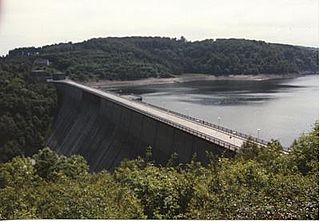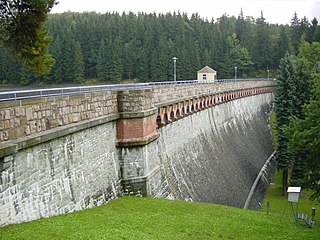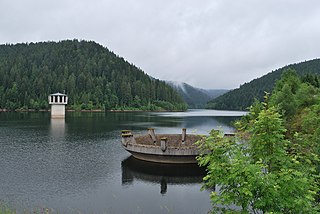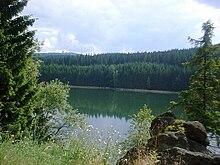
Eibenstock is a town in the Erzgebirgskreis, Saxony, Germany. It is situated in the western Ore Mountains, near the river Mulde.

Johanngeorgenstadt is a mining town in Saxony’s Ore Mountains, 17 km south of Aue, and 27 km northwest of Karlovy Vary. It lies in the district of Erzgebirgskreis, on the border with the Czech Republic, is a state-recognized health resort (Erholungsort), and calls itself Stadt des Schwibbogens. Its population decline since the 1950s has been extremely severe, falling from 45,000 residents in 1953 to only about one twelfth of that now.

Bockau is a municipality in the district of Erzgebirgskreis in the Free State of Saxony in Germany. The community is known for growing and researching herbs. Owing to its centuries-old cultivation of angelica, whose roots are used in making liqueurs, Bockau is also known locally by the nickname Wurzelbucke.

Sosa is a former municipality in the western Ore Mountains, in the Erzgebirgskreis, Saxony, Germany. It is a state-recognized health resort, that has belonged to the town Eibenstock since 1 January 2011.

The Rappbode Dam is the largest dam in the Harz region as well as the highest dam in Germany. Together with several other dams and retention basins, it forms the flood protection system for the eastern Harz.

The Chemnitz–Adorf railway is a branch line in Saxony, Germany that was built and operated by the Chemnitz-Aue-Adorfer Eisenbahn-Gesellschaft (CAAE). The 115 km long line originally ran from Chemnitz in a southwesterly direction along the valley of the River Zwönitz to Aue. From Aue the line ran along the Zwickauer Mulde to Muldenberg and up to Schöneck and through Markneukirchen to Adorf in Vogtland.
The Söse Dam is a dam in the Lower Saxon part of the Harz mountains near Osterode in the German state of Lower Saxony.

The Wippra Dam or Wipper Dam is a dam on the river Wipper in the Harz mountains. It lies near Wippra, not far from Mansfeld and Hettstedt in Saxony-Anhalt. It was built between February 1951 and November 1952.

The Neustadt Dam, also known as the Nordhausen Dam, is the oldest dam in the Free State of Thuringia in Germany. It supplies drinking water to the town of Nordhausen. The dam is a curved gravity dam made of rubble stone, based on the Intze Principle. The dam was built in 1904–1905, in the southern Harz mountains, and it was raised by a further 6.26 metres in 1922–1923. The impounded stream is the Krebsbach. The operator of the dam is the Thüringer Fernwasserversorgung; the water is supplied to the Wasserverband Nordhausen.

The Ecker Dam is a gravity dam in the Harz mountain range near Bad Harzburg, Germany. Constructed between 1939 and 1943, it is today operated by the Harzwasserwerke company. The dam's reservoir impounds the waters of the Ecker river and mainly serves for drinking water supply.

The Königshütte Dam is a dam in the German state of Saxony-Anhalt in the Harz mountains. It impounds the River Bode and lies between Königshütte and Susenburg. It is a so-called storage reservoir (Überleitungssperre) forming part of the Rappbode Dam system.

The Upper Harz Water Regale is a system of dams, reservoirs, ditches and other structures, much of which was built from the 16th to 19th centuries to divert and store the water that drove the water wheels of the mines in the Upper Harz region of Germany. The term regale, here, refers to the granting of royal privileges or rights in this case to permit the use of water for mining operations in the Harz mountains of Germany.

The Wendefurth Dam near Wendefurth in the Harz is one of the dams downstream of the Rappbode Dam, that provides flood protection as well as impounding the River Bode to provide the lower reservoir for the Wendefurth Power Station. In addition it is a bathing lake and also supports fish farming.

The Saidenbach Dam is a dam in the German state of Saxony. Its reservoir supplies drinking water to Chemnitz and, in conjunction with the Central Ore Mountain Dam System and its other dams - Neunzehnhain I und II and Einsiedel - contributes to the supply of the region covered by the South Saxony Long Distance Water Association.

Cranzahl Dam is a dam in the Free State of Saxony in East Germany. It was built from 1949 to 1952 near Sehmatal–Cranzahl and the Bärenstein mountain in the Ore Mountains to supply drinking water to Annaberg-Buchholz and the surrounding area. Together with the Sosa Dam it was one of the two biggest dam construction projects of the newly created GDR. In keeping with the time it was called the Dam of Friendship.

Eibenstock Dam near Eibenstock in the Ore Mountains, Germany, is the largest dam in the Free State of Saxony in terms of the height of the dam above the valley floor, and its reservoir is the largest in volume in Saxony. The dam impounds the waters of the Zwickauer Mulde and supplies drinking water to the region of Chemnitz and Zwickau, as well as providing flood protection, delivering extra water during times of drought and, to a lesser extent, generating electricity from hydropower. Its dimensions make it the second largest drinking water reservoir in Germany's new federal states.

Einsiedel Dam is located in the German Free State of Saxony. Its reservoir supplies drinking water to Chemnitz and, in conjunction with the Central Ore Mountains reservoir system, that includes the reservoirs of Neunzehnhain I, II and Saidenbach also supplies water to the entire region covered by the South Saxony Long Distance Water Association.

The Kleine Kinzig Dam is a dam which was commissioned in 1984 in Reinerzau near Freudenstadt in Germany's Black Forest. It lies within the state of Baden-Württemberg and supplies drinking water, provides flood protection, drought protection and power generation using hydropower. It impounds the Kleine Kinzig river; the dam belongs to the Kleine Kinzig Special Purpose Association

The Ohra Dam is a dam which impounds the Ohra in the German state of Thuringia. It lies on the northern side of the Thuringian Forest in the county of Gotha near the village of Luisenthal.

Quitzdorf Dam is a dam near Quitzdorf am See, Germany. It is located in the municipality of Quitzdorf am See in the Upper Lusatia region of Saxony. The lake is used for service water supply, flood protection, low water elevation, recreation and nature conservation. In terms of area, it is the largest reservoir in Saxony and was the largest inland water body in Saxony until the Lohsa II and Bärwalde reservoirs were flooded. According to criteria established by the International Commission on Large Dams, it is a large dam.























